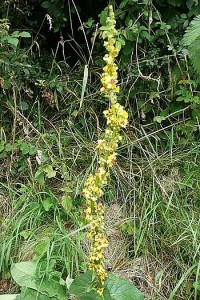This article outlines the history of Verbascum thapsus, mullein, and its potential benefits for use with tuberculosis.
Abstract
Common mullein weed (Verbascum thapsus ) has a large number of synonyms and old local “nick names” which connect the plant with mycobacteria. A strong history of medicinal use has been uncovered for the treatment of tuberculosis, tubercular skin disease, leprosy, and mycobacterial disease in animals. Here, we examine problems encountered in treating such diseases today, the historical and scientific links between mullein and pathogenic bacteria, and the possibility that this common weed could harbour the answer to beating one of the world’s biggest infectious killers.
Evid Based Complement Alternat Med. 2011;2011. pii: 239237. Epub 2010 Sep 19.
1. Tuberculosis: Modern Day Scourge
It has killed ancient Egyptians and Iron Age British settlers as well as John Keats, D. H. Lawrence, and Vivien Leigh. Throughout history, it has left its mark on our ancestors as “phthisis”, “consumption”, and the “white plague”. But far from being a disease of the past, Tuberculosis (TB) is now killing almost 5000 per day, or one person about every 20 seconds [1]. The World Health Organisation (WHO) has declared a global emergency [2] and as antibiotic resistance increases [3], the hunt for new treatments continues.
2. Treating Tuberculosis—Present and Future
Mycobacteria are notoriously tough micro-organisms. Their intrinsic resistance to many antibiotics can be largely attributed to the unique structure of the cell envelope, which is rich in high molecular weight fatty acids and peptidoglycan cross-linkage [6]. Permeability is mainly restricted to lipophilic molecules [7] such as the anti-TB agent Rifampicin. This envelope also seems to be a dynamic structure—changing according to whether the bacterium is growing or persisting in host tissues [8]. A combination of antibiotics is therefore required to treat mycobacterial infection. Current Irish recommendations are that all new TB patients (including HIV positive) who have not previously been treated with anti-TB drugs receive the internationally accepted first line treatment regimen outlined by the WHO [9]. This includes initial treatment with Isoniazid, Rifampicin, Pyrazinamide, and Ethambutol for two months, followed by a four-month continuation phase of further treatment with Isoniazid and Rifampicin. In the case of a 60kg adult, this equates to over half a kilogram of antibiotics. Monthly sputum samples are examined for the continued presence and/or reappearance of tubercle bacilli—in this case, treatment needs to be modified due to resistance and may be extended to 9 months or longer. Extensively drug-resistant TB (often incurable) first emerged in 2006 [10] and has now been reported in over 50 countries worldwide [1]. The WHO recently reported that in some areas of the world, one in four people with TB becomes ill with a form of the disease that can no longer be treated with standard drugs [11].
Three of the four first-line antibiotics listed above work by directly or indirectly affecting the synthesis of the mycobacterial cell wall and this remains an area of pharmaceutical interest [12]. The three compounds which are currently in phase II/III clinical development (namely moxifloxacin, PA824, and TMC207) elicit their activity by the inhibition of enzymes involved in cell division, respiration, and mycolic acid synthesis [13, 14]. While these new drugs were synthetically engineered, natural compounds are once again playing a bigger role in the fight against TB. Plant extracts have been shown to be capable of inhibition comparable to that of Streptomycin [15], have shown activity against multidrug resistant TB [16], and have been shown to improve the immune response to TB both in vitro and in clinical trials [17, 18]. Pharmaceutical science is increasingly beginning to realise that the “silver bullet” compounds we are attempting to engineer may have been present in nature all along.
